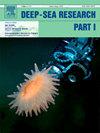北大西洋和北太平洋深海溶解氧的年代际变化
IF 2.1
3区 地球科学
Q2 OCEANOGRAPHY
Deep-Sea Research Part I-Oceanographic Research Papers
Pub Date : 2025-06-16
DOI:10.1016/j.dsr.2025.104534
引用次数: 0
摘要
在海洋上部和中部的深度有溶解氧浓度下降的记录,但对深海的了解较少。用温克勒滴定法分析了几十年来溶解氧的长时间序列测量结果,揭示了北大西洋和北太平洋深海六个站点的区域差异。东北太平洋4000 ~ 4200 m深度两个站(PAPA站和m站)溶解氧明显下降。在北大西洋的北极地区也有类似的下降趋势,但并不明显(HAUSGARTEN)。然而,北大西洋的两个温带站(PAP, BATS)和北太平洋中部的一个热带站(ALOHA)在相似的时间段内,在相似的深度>;4000 m处,溶解氧没有显著减少。为了监测全球深海过程和气候变化的影响,将需要持续的长时间序列观测。我们将这些罕见的长期观测结果与持续高温室气体排放情景下的历史(1850-2014)和预估(2015-2100)强迫模式估算值进行了比较。本文章由计算机程序翻译,如有差异,请以英文原文为准。
Decadal change in deep-ocean dissolved oxygen in the North Atlantic Ocean and North Pacific Ocean
Declining dissolved oxygen concentrations are documented at upper and mid ocean depths, but less is known about the deep ocean. Long time-series measurements of dissolved oxygen analyzed with Winkler titration over several decades reveal regional differences at six stations in the abyssal North Atlantic Ocean and North Pacific Ocean. A significant decline in dissolved oxygen was evident at two stations in the northeast Pacific Ocean at 4000–4200 m depth (Stations PAPA and M). A similar decreasing but insignificant trend was recorded in the Arctic region of the North Atlantic Ocean (HAUSGARTEN). However, there was no significant decrease in dissolved oxygen at two temperate stations in the North Atlantic Ocean (PAP, BATS) and at one tropical station in the central North Pacific Ocean (ALOHA) all at similar depths >4000 m over similar time periods. Continued long time-series observations will be needed to monitor global deep ocean processes and the impact of changing climate. We compare these rare long-term observations with model estimations from historical (1850–2014) and projected (2015–2100) forcing under a continued high greenhouse gas emission scenario.
求助全文
通过发布文献求助,成功后即可免费获取论文全文。
去求助
来源期刊
CiteScore
4.60
自引率
4.20%
发文量
144
审稿时长
18.3 weeks
期刊介绍:
Deep-Sea Research Part I: Oceanographic Research Papers is devoted to the publication of the results of original scientific research, including theoretical work of evident oceanographic applicability; and the solution of instrumental or methodological problems with evidence of successful use. The journal is distinguished by its interdisciplinary nature and its breadth, covering the geological, physical, chemical and biological aspects of the ocean and its boundaries with the sea floor and the atmosphere. In addition to regular "Research Papers" and "Instruments and Methods" papers, briefer communications may be published as "Notes". Supplemental matter, such as extensive data tables or graphs and multimedia content, may be published as electronic appendices.

 求助内容:
求助内容: 应助结果提醒方式:
应助结果提醒方式:


